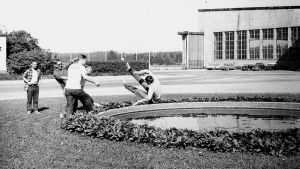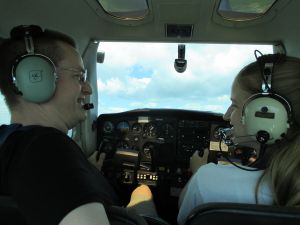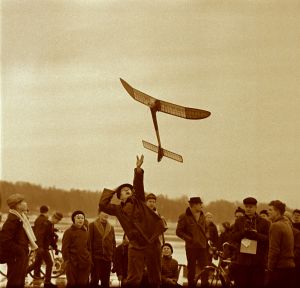Aviation tradition of Helsinki-Malmi Airport
| Aviation tradition of Helsinki-Malmi Airport | ||||
|---|---|---|---|---|
|
Practitioners and people who know the tradition well
Aviation, mankind's oldest dream, first became accessible to the general public in the 20th century. In just one hundred years, the modest first leaps have evolved into one of the most significant modes of transport, making every place on the globe accessible within 24 hours.
The history of heavier-than-air aviation has been written in earnest only for about 120 years. In the aviation community of Malmi Airport, over a period of more than 80 years, generations of pilots have earned their wings, and newcomers have always been welcomed along with others who are interested in aviation-related activities. The members of Malmi's aviation community, from young hatchlings to veterans with decades of service under their belt feel part of a tradition that is exceptionally fine, old and vibrant even on international scale, made possible by a historic airport that is also a significant part of the local identity of the people living in northeastern Helsinki. Learning to fly and taking to wing are an age-old dream that comes true at Malmi both in commercial pilot schools and in clubs and associations, applying mind, heart and soul all the way from the basics to professional level.
Helsinki-Malmi Airport's thriving community of flying schools, aviation clubs, companies doing aviation work, and maintenance and repair businesses supporting them is a unique and historic cluster of aviation tradition and know-how in Finland. Its unbroken evolution extends from the airport's early era in the 1930s to the present day. The versatile aviation activities at Malmi make it one of the busiest airports in Finland by operations. Malmi is a uniquely large and diverse aviation community in Finland, passing unwritten aviation wisdom, tradition, history and the principles of good airmanship from one generation of aviators and aviation enthusiasts to the next.
Practising of the tradition
At the core of Malmi's aviation tradition is passing on the aviation-related know-how, good practices and tradition in the context of actual aviation and pilot training. In addition, the community takes care of the airport's operational preconditions, cherishes its historical milieu, collects and records anecdotes and oral tradition and communicates the cultural heritage to the general public.

Intangible aviation heritage and the tradition globally known as "good airmanship" contains a vast amount of oral information not written down in textbooks. Lessons learned the hard way in the pioneering days of aviation, such as "in a forced landing, close the fuel cock and turn off the mains switch before ground contact" have made their way also to written aviation tradition, but a vast amount of practical knowledge that improves safety and everyday practising of aviation is still passed from one generation to the next by word of mouth, e.g., "showing the landing lights for a short time makes you easier to detect for an oncoming aircraft."
Another practical wisdom from teacher to student is that in the final stage of landing, one should steer with one hand and hold the other hand on the throttle, so that in case of the wind changing suddenly, it is possible to quickly adjust thrust to prevent the aircraft from sinking onto the runway too fast. This kind of unwritten good aviation practices are universal and countless in number. However, only a sufficiently large and vibrant aviation community guarantees that they are remembered and transmitted. A pilot's training is never complete, it is a lifelong learning process: it's common knowledge in aviation communities around the world that pilots operating alone outside the community are more likely to develop bad habits and practices that undermine safety.
Aviation is such a wide-ranging field that there are many subcultures. They are widely represented at Malmi, the largest aviation community in Finland. Many of the basic practices of good airmanship are common to all kinds of aviation, but professional pilots, private pilots, ultralight pilots, helicopter pilots, hot air ballooners and parachutists also have their own specific practices and traditions which may not be familiar to the others. Similarly, different ratings (e.g. night rating, instrument rating, multi-engine rating) have their own specific wisdom. However, everyone involved in Malmi's various aviation subcultures feels strongly connected as part of Finland's largest and most diverse aviation community, united by mankind's oldest dream and its realization. More than one third of all pilot's license holders in Finland live in the Helsinki Metropolitan Area. The aviation community at Malmi Airport is the beating heart of Finnish general aviation and a vital mediator of aviation tradition.
For decades, air shows and other aviation-related events have been held at Malmi Airport, typically attracting tens of thousands of spectators who share in the dream of aviation. Examples include the decades-old Mother's Day flight show tradition in May (less regular in the recent years due to the uncertainty of Malmi's future), numerous commercial aviation shows, and recently the practically annual Open Doors Days and pilots' fly-in events that are also open to the public. Events to highlight the cultural heritage of Malmi have also been organized to disseminate the cultural heritage value of the historic airport, e.g., in connection with the European Heritage Days. Through such events, the aviation tradition of Malmi Airport also brings joy and inspiration to the general public.
The background and history of the tradition
Up to the 1920s, being an aircraft pilot was one of the most dangerous professions. In the early days of aviation, pilots were often injured or killed not only because of the unreliable technology, but also because of a variety of immature safety practices and attitudes, such as not bothering to close the fuel cock and turn off the mains switch in a forced landing situation, which could lead to a catastrophic fire due to sparking from damaged electric devices. During the decade before World War II, as the passenger airport network developed and traffic grew, safety became the maxim of all aviation practices.
The roots of the aviation tradition of Helsinki-Malmi Airport lie in the latter half of the 1930s, when its first aviation schools opened for business. World War II cut short their early success and expansion, but in the Continuation War from 1941 onwards the airport served both scheduled traffic and military aviation until September 1944, when the Allied Control Commission took it over after Finland sued for a separate peace. The airport was returned to Finnish control on 5 January 1947, and its heyday as the international airport of the Finnish capital reached its pinnacle in the early 1950s.

In that era, Malmi Airport became the home of many significant aviation and aircraft maintenance businesses, importers and sales representatives of aircraft and avionics ase well as numerous aviation clubs and flying schools. This laid the groundwork for the airport's planned new role as the capital's general aviation centre after scheduled traffic moved to the new Helsinki-Vantaa Airport in 1952.
Over the decades, generations of student pilots, instructors, private aviators, flight captains, military aviators and mechanics have waited for the morning fog to clear at Malmi's historic hangar or in the terminal's restaurant over a cup of coffee, passing on good airmanship, aviation tradition and the airport's history, customs, incidents and anecdotes in discussions. This important form of passing on oral tradition is known in Finnish as "canteen time".
The oldest flying schools still operating at Malmi opened for business in the 1960s, and the aviation community of Malmi Airport is one of the most significant pilot training centres in Finland. The rich history and traditions of Malmi Airport, cherished and passed on by its aviation community, continue unbroken to the present day on this airport that has survived almost perfectly in its original shape and size and has a heritage that covers 3/4 of the world history of heavier-than-air aviation.
The transmission of the tradition

Malmi's aviation tradition is passed on in the same way it always was: by being together and doing together. The oral tradition, good airmanship, history and anecdotes are passed on and accumulated from one generation to the next, and also spread to the knowledge of the general public, especially making use of the possibilities provided by modern means of communication. From one year and decade to the next, the "bite of the aviation fly" continues to bring new generations to join Malmi's aviation tradition.
There are many other types of communal activity besides passing on the principles of good airmanship and the knowledge of traditions and history. Aviation clubs and associations constantly engage in teamwork in, e.g., aircraft maintenance. Scheduled maintenance involves both young beginners and experienced professionals who in the course of maintenance work convey knowledge of aircraft structures, systems and proper maintenance practices as practical training. Technical knowledge of aircraft is important for every pilot, and is best learned through hands-on practice.
The future of the tradition
The fast progress of new aviation technologies, such as electric aircraft and intelligent unmanned cargo-carrying solutions, provide the aviation community of Malmi Airport with an excellent chance to thrive and develop in the future. Passing on living tradition, history and good aviation practices to new generations continues. Malmi is the only free-schedule international airport in the capital region, and with its comprehensive pilot training and aircraft rental services and numerous aviation clubs and associations it keeps alive the dream of aviation for more than a million people. There is no doubt of the vitality and future of its aviation community and tradition if the preconditions of general aviation are preserved.
The trend to separate free-schedule light air traffic and heavy scheduled air traffic to their own airports began in Helsinki and around the world in the late 1940s, when it was decided to keep Malmi Airport operational specifically for the needs of light air traffic and general aviation. The expected rapid expansion of electric aviation and the significant reduction in aircraft maintenance costs will open completely new vistas for Malmi's long aviation tradition. The overall outlook for small city airports is very promising. In Central Europe and the United States, the use of such airports, e.g., for business flights is already commonplace due to the smooth service they provide.
Electric aviation is already a reality, and one electric aircraft already operates at Malmi. With significantly lower maintenance and energy costs, their breakthrough will be a clear trend for the foreseeable future. Satellite-based instrument approach systems are already commonplace in aviation and allow commercial air traffic to even small airports without the need for expensive ground installations. Within ten years, several electric aircraft types with 10 to 20 passenger seats will be available for commercial traffic, allowing environmentally sound and almost noiseless passenger flights over shorter distances via small city airports like Malmi, avoiding congested large airports like Helsinki-Vantaa.
As before, the contribution of new technology to the canon of good airmanship will be woven into the knowledge of the aviation community as the industry evolves. New wisdom on flying on battery power in the Nordic climate and understanding the amount of electricity available in different weather conditions will undoubtedly enrich the aviation community's knowledge.
Malmi Airport's genius loci and the long tradition of its aeronautical community are invaluable parts of the metropolitan area's cultural heritage, without which more than a million residents of the capital region would have no chance of sharing in the dream of aviation in the area where they live.
A shadow hangs over the future of Malmi Airport's aviation community, though, due to the City of Helsinki's plans to close down the historic airport and turn its built cultural environment of national significance into a housing project in spite of the fact that no viable other place has been found for Malmi's flying schools and the rest of the aviation community. Their livelihood consists not only of pilot training but also, e.g., aircraft rental, for which there isn't enough demand further from capital region. The dissolution of Malmi's large and cohesive aviation community would inevitably also mean the disappearance of the intangible heritage that has been accumulated over decades.

The community/communities behind this submission.
Friends of Malmi Airport Association
Finnish Aeronautical Association
Aircraft Owners and Pilots Association (AOPA) Finland
Aviation Museum Society Finland
Bibliography and links to external sources of information
S. Sipilä, R. Haikarainen, H.-M. Wahl, "Malmi - Helsingin lentoasema". Minerva 2008 (2nd edition 2018), 333 p. (in Finnish)
Malmi Airfield Association (airfield operator)
Daily operations log at Malmi Airport
Heritage Finland: Built Cultural Environments of National Significance (RKY 2009)
World Monuments Fund List of 100
Aviaton Museum's pictures of Helsinki-Malmi airport in Finna
Old newsreels (YLE Live Arena, KAVI)
